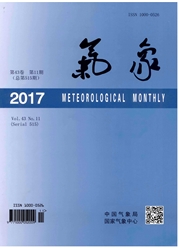

 中文摘要:
中文摘要:
在降水过程中,固态降水粒子下落穿越0℃等温线的融化效应会引起雷达反射率因子增大,产生亮带。文章基于北京房山地区的边界层风廓线雷达的探测资料,对2014年8—10月四次典型的层状云降水和以层状云为主的混合性降水过程进行特征统计,提出了适用于该季节、该地区的0℃层亮带自动识别订正算法,并使用这种算法对一次层状云为主的混合性降水天气过程进行了识别研究,通过与探空资料、多普勒天气雷达资料的对比检验,结果表明该算法可以有效识别该季节、该地区的0℃层亮带,通过亮带订正,融化区的回波强度高值区得到了有效抑制,原亮带高度附近回波强度廓线的显著弯曲消失,融化区之外的回波强度基本没有变化。
 英文摘要:
英文摘要:
The melting process in the melting layer gives rise to the enhancement of radar reflectivity, which is known as the 'bright band'. An automatic identification and correction algorithm of bright band is presented in this paper. This algorithm is developed from the characteristics of stratiform or blended precipitation based on WPR data in Fangshan, Beijing, from August to October 2014. A typical blended precipitation episode from 1 to 2 September 2014 is analyzed by using this algorithm. The identified bright band parameters are compared with sonde and Doppler radar data, which is verified to be reliable. After bright band correction, the high echo intensity areas are restrained, and the obvious curve of the vertical profile of echo intensity near bright band height disappears.
 同期刊论文项目
同期刊论文项目
 同项目期刊论文
同项目期刊论文
 期刊信息
期刊信息
